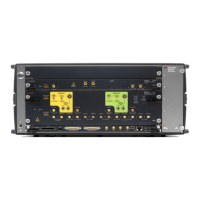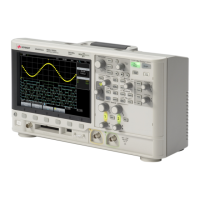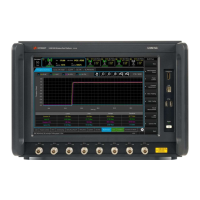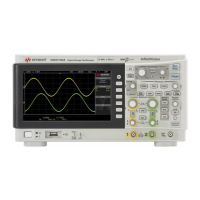514 Keysight M8000 Series of BER Test Solutions User Guide
8 Working with Measurements
Name Description
The following is an example of the Binary algorithm.
At a single SJ frequency, if the true pass/fail SJ amplitude is 0.7
UI, the minimum step size is 0.1 UI, the template minimum is 0.1
UI, and the template maximum is 1.0 UI, then the binary algorithm
would follow these test points:
1 Template maximum 1.0 UI - FAIL
2 Template minimum 0.1 UI - PASS
3 Log midpoint between 1.0 UI (FAIL) and 0.1 UI (PASS) = 0.32 UI
- PASS
4 Log midpoint between 1.0 UI (FAIL) and 0.32 UI (PASS) = 0.57
UI - PASS
5 Log midpoint between 1.0 UI (FAIL) and 0.57 UI (PASS) = 0.75
UI - FAIL
6 Log midpoint between 0.75 UI (FAIL) and 0.57 UI (PASS) = 0.65
UI - PASS
7 Log midpoint between 0.75 UI (FAIL) and 0.65 UI (PASS) 0.70
UI - PASS
8 Last step size < 0.1 UI, highest passing SJ amplitude is 0.70 UI
Binary + down linear The Binary + Down Linear algorithm is the same as the Binary
algorithm followed by the Down Linear algorithm. Refer to the
descriptions for Binary and Down Linear in this table.
Binary + up linear The Binary + Up Linear algorithm is the same as the Binary
algorithm followed by the Up Linear algorithm. Refer to the
descriptions for Binary and Up Linear in this table.
Down linear The Down Linear search algorithm starts at the maximum jitter
value determined by the template.
If a BER measurement has errors above the measurement
threshold, the jitter amplitude is adjusted lower by the linear step
size.
This algorithm exits when the BER is measured below the
measurement threshold BER, or if the last amplitude
measurement point was at the minimum jitter value in the
template.
The jitter tolerance result at each jitter modulation frequency is
the highest jitter amplitude at which the measurement was made
below the threshold BER. However, if the device is intolerant of
even the minimum jitter value, the result is not valid and is not
plotted.

